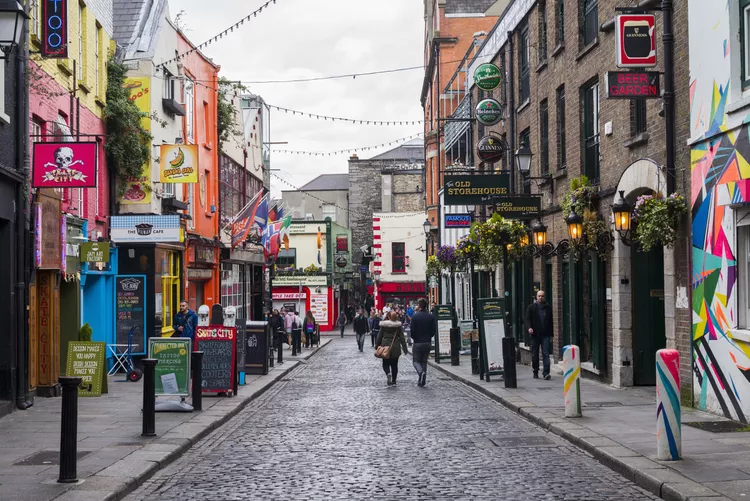1. Overview of Temple Bar: A vibrant area known for its artistic flair and nightlife.
2. Historical Background: From marshland to a bustling neighborhood.
3. Activities and Highlights: Restaurants, pubs, and cultural experiences.
4. Pros and Cons: Evaluate the advantages and disadvantages of visiting.
5. Nearby Attractions: Explore Trinity College and other famous sites.
Temple Bar: A Lively Neighborhood in Dublin
Temple Bar is often hailed as Dublin’s “bohemian quarter.” This dynamic area is brimming with entertainment, art, and culinary delights, making it one of the top attractions in Dublin. It’s an ideal location for experiencing live Irish folk music while enjoying a vibrant atmosphere filled with laughter and pints.
Historically, Temple Bar was not the renowned destination it is today. Situated on the south bank of the River Liffey, this area was once marshland, which has evolved into a prosperous neighborhood over the centuries. Its colorful past includes a red-light district and, ultimately, a cultural hub rich with tourist-friendly pubs.
History of Temple Bar
Temple Bar’s location near the River Liffey reflects its historical significance. Initially, this shoreline was transformed in the 17th century into affluent residential areas. The name “Temple Bar” likely derives from a London district, inspired by the British rule of the time. Influences from London are evident in the street names within Temple Bar.
As time progressed, the neighborhood suffered decline. By the 18th century, it became notorious for brothels, and it remained less desirable for decades. However, in the 1990s, a shift occurred when a private company aimed to revitalize the area, attracting artists and creatives. Consequently, what began as a decline transformed into the bustling Temple Bar known today.
What to Do and Expect in Temple Bar
Today, Temple Bar is characterized by its cobblestone streets lined with numerous restaurants, cafés, and pubs. Visitors can explore shops ranging from local crafts to quirky souvenirs. In addition to being a vibrant tourist destination, Temple Bar is home to art galleries and creative venues like the Irish Film Institute and Project Arts Centre. Despite the array of attractions, many are drawn to Temple Bar primarily for its lively nightlife and beer selection.
However, as the day progresses, the atmosphere shifts. Mornings are tranquil, afternoons begin to liven up, and by evening, the area is bustling with diners and tourists. Nevertheless, visitors should be aware of potential rowdiness and pickpockets, especially later in the night. Therefore, while Temple Bar is a great starting point for an evening out, it is advisable to consider venturing elsewhere before the night gets too late.
Pros and Cons of Temple Bar
The Pros of Temple Bar:
- Unique artistic businesses adorn the streets by day.
- Diverse assortment of restaurants and entertainment venues.
- Hub of Dublin’s nightlife, offering a vibrant experience.
- Inviting atmosphere during the evenings.
The Cons of Temple Bar:
- Can become crowded with loud and rowdy groups.
- Higher prices compared to other Dublin areas.
- Potential for pickpockets, particularly late at night.
- Difficulties in hailing a taxi at night.
Despite its challenges, Temple Bar remains one of the most sought-after tourist destinations in Dublin, offering a vibrant mix of locals and visitors. Nonetheless, those seeking a more authentic “Irish pub experience” might wish to explore other options throughout the city.
Best Bars and Pubs in Temple Bar
The nightlife in Temple Bar is renowned, with many pubs frequently visited by tourists. The top picks include:
The Porterhouse: This establishment stands out as Dublin’s first pub brewery from 1996, serving its own house beers while providing a classic Irish menu and live music seven days a week.
The Oliver St. John Gogarty: Popular amongst the younger crowd with its upstairs hostel, this pub features nightly traditional music sessions and a lively atmosphere.
Quays Bar: This bar and restaurant come alive with live music starting at 3 pm each day, offering a broad menu that spans traditional Irish to modern cuisine.
The Temple Bar Pub: Established in 1840, this is one of the oldest pubs in the area, boasting an extensive whiskey collection and fresh oyster platters, along with daily live music.
The Auld Dubliner: A relatively quieter venue, this pub hosts traditional music sessions and is more suited for a relaxed hangout atmosphere.
Location of Temple Bar
Situated in central Dublin, Temple Bar lies on the south bank of the River Liffey. The river forms the northern edge of the neighborhood, while Dame Street to the south, Fishamble Street to the west, and Westmoreland Street to the east complete the area.
What Else to Do Nearby
Located just a five-minute walk from Temple Bar, Trinity College is a must-visit. Stroll down Dame Street, turn left at College Green, and marvel at this prestigious university, which sits opposite the Bank of Ireland.
Walking further along Dame Street, you will discover Christ Church Cathedral, an impressive medieval church that predates the more famous St. Patrick’s Cathedral.
Moreover, nearby Dublin Castle features the free-admission Chester Beatty Library, a worthwhile stop for any visitor. To head back towards O’Connell Street, crossing the iconic Ha’Penny Bridge will provide a picturesque view of one of Dublin’s most recognized landmarks.





